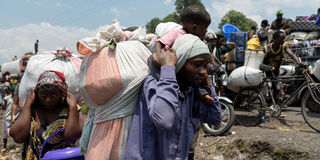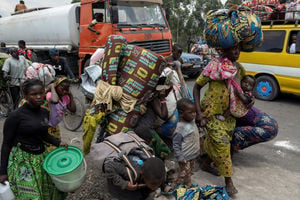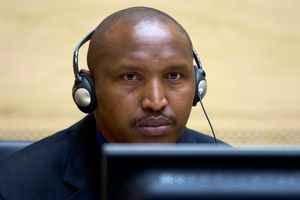
Congolese people carry their belongings as they flee from their villages around Sake in Masisi territory, following clashes between M23 rebels and the Armed Forces of the Democratic Republic of the Congo on February 7, 2024.
Southern African Development Community (SADC) troops have been in the Democratic Republic of Congo for five months. So what has been the achievement? Observers say South African troops have stepped up fight against M23 rebel group, which also means the possibility of peaceful negotiations is distant.
The development is at variance with the predecessor mission from the East African Community countries (EACRF), which sought to buffer the frontlines to encourage dialogue. It helped achieve some push-back of M23 without firing a shot but also angered Kinshasa for not targeting what it called "terrorists."
For SADC, however, this stance has come at the cost of more deaths than EACRF.
The South African army, a member of this mission known as SAMIDRC, announced that it had lost a soldier on May 31.
“The South African National Defence Force (SANDF), confirms that on Thursday, 30 May 2024, the SANDF members came into contact with M23 at Sake, in the battle ensuing between M23 and our forces. Thirteen members were injured and one was fatally wounded. All the injured members were evacuated to Goma Hospital and are recuperating,” it said.
Col Ndjike Guillaume, Spokesman for the Congolese army (FARDC) in North Kivu, accused M23 and the Rwandan military of having a hand in it.
“South African soldiers were wounded, including one fatally, early on Thursday 30 May, when the Rwandan army and their M23 allies began indiscriminate bombardment of the town of Sake and the surrounding area. The FARDC and its partners reacted effectively. At that stage, the enemy movement was stopped dead in its tracks," he claimed.
Rwanda has denied playing a role in the conflict even though Kinshasa has insisted M23 are backed by Kigali, claims also sustained by the US and France.
This is the fifth South African soldier to die since the deployment of that country's troops within the framework of the SADC. Like the first four who lost their lives, hit by mortars, the fifth is also South African. Between December 2023 and January 2024, SADC troops were in the DRC, alongside the Congolese army, in the war between the FARDC (Congolese army) and the rebels.
It means Goma now faces a threat of violence. Several mortars have fallen in the town, killing civilians and children. The fighting got closer, 20 kilometres from Goma, in the town of Sake, the last lock before reaching the capital of North Kivu. It is in this locality that South African and Congolese troops have set up to block the rebel assaults.
Nicaise Kibel Bel, a military expert based in Goma, believes that the strategy to escalate the fight by the rebels has two aims: to put pressure on the government in Kinshasa to open a dialogue and to send a message to South African President Cyril Ramaphosa to agree to withdraw his country's troops fighting under the SADC banner.
“This is just a diversion. It's a message sent to the Congolese government and the population, saying we want to take over Goma and push the government to open a dialogue because the government is doing nothing to achieve dialogue," Bel said.
And indeed, these offensives are creating debate among Congolese citizens. As for the attacks on South African troops, Kibel Bel points out that the current context in South Africa needs to be taken into account. There are elections, and the ANC is being challenged. And the rebels are putting pressure on President Ramaphosa and the South African people by saying, "You South Africans, look at how Cyril Ramaphosa has sent your compatriots to die in the Congo.”
Bel argues that the attacks were expected, however, as the group was always opposed to the mission from the start, and hence, the troops should not take the bait and leave.
In South Africa, some leaders have used the election season to accuse the South African president of sending troops into dangerous territory.
“Cyril Ramaphosa wants to kill our soldiers in DRC, they are not properly trained, they're sent to be killed," declared Julius Malema when the troops landed in the DRC.
In Kinshasa, it is not certain that the intensification of the war will prompt the authorities to change their policy on the war in favour of negotiations.
Under a new government structure, Deputy Defence Minister Jean-Pierre Bemba has been replaced by Guy Mwadiamvita. Although a novice in matters of war, Mwadiamvita is expected to follow in the footsteps of Bemba and President Félix Tshisekedi in rejecting all dialogue.
Like Tshisekedi, Mwadiamvita belongs to the UDPS (Union for Democracy and Social Progress), a party known for its tough stance on the war in the eastern part of the country.
Daddy Saleh, a political analyst and lecturer in North Kivu, "the misunderstanding of this war is what is preventing us from finding solutions.”
Saleh sees it as an "economic war.”
“The aggressors are not going to stop until they achieve their goal, which is to divide the DRC and plunder the minerals as much as possible," Saleh said.
“The war will continue and the DRC must invoke Article 86 of the Constitution to declare a state of war to block the path of the enemies of peace and put an end to this war.”
The situation in Kivu augurs well for the continuation of the war despite the harmful effects on the civilian population in part of North Kivu.









